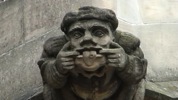Introduction
Bénigne de Bacilly’s treatise,
Remarques curieuses de l’art de bien chanter,
first published in 1668, is typical of mid-to-late 17thC French treatises on music
in its application of rhetorical principles to performance.
Here, he states that singing airs is analogous to declaiming a discourse
– ‘one must know how to sing well and declaim well at the same time’ –
alluding only to the fifth part of rhetoric, actio.
The emphasis in Bacilly’s treatise upon pronunciation
underscores the dominance of performance over composition
in the seventeenth-century musical experience in France;
thus, as Bacilly insists, the rules that govern singing
French-language airs must also apply to their composition.
Strategies related to actio provided composers with a means
of fulfilling vocal music’s primary aesthetic function,
a function it shared with oration:
moving the passions associated with a text and its recitation.
Just how this was accomplished is articulated in treatises on rhetoric, not music.
Rhetoricians identify two ways in which passions are represented in recitation:
through
NOMBRE or the rates of speech
and
ACCENS or tones of voice.
Nombre is specifically addressed by Bernard Lamy who was concerned with
the physiological and psychological effects of various qualities of sound
in his De l’art de parler, first published in 1675.
Although Lamy considers only language in his treatise,
his advice was easily applicable to another sound source:
MUSIC.
And indeed, in his
L’Art de la poësie françoise et latine avec une idée de la musique
from 1694, Pherotée de la Croix applied Lamy’s theories to musical sounds.
Those sections of La Croix’s treatise that concern music
were copied directly from Lamy’s treatise,
differing only by adding the word ‘music’ to Lamy’s statements.
Both Lamy and La Croix stress
the effects on the soul
of the numerical proportions of speech called nombre.
La Croix, copying directly from Lamy, writes:
‘one calls number, in the art of speaking and of singing,
what the ears perceive as proportionate in the recitation of a discourse,
either following the proportion of the measure of time,
or according to the just distribution of the intervals of breath.’
Both Lamy and La Croix assert that
‘proportion in the pronunciation
of discourse and music is linked to the passions’.
As La Croix points out:
‘It is a question of making the numbers conform to the things one expresses,
in order to excite with success the movements (passions) that one wants.’
Several rhetoricians also describe
the tones of voice, called
ACCENS,
associated with passionate recitation,
defined by Marin Mersenne as
‘an inflection or modification of the voice or of the word
by which one expresses the passions
or affections naturally
or by artifice.’
Mersenne notes that
‘la musique accentuelle’
incorporates the accents
used for raising or lowering syllables
(l’aigu and le grave
or high and low accents)
and must be accompanied by a quickness
or slowness of movement (nombre).
Rhetoricians indicate, for example,
that boldness or courage is characterized by
a voice that is lofty, forceful, and full of energy,
while happiness is portrayed by
a voice that is easy, brisk, and flowing.
Both rates of speech and tones of voice combine to express passion,
and both could be easily imitated through a variety of musical devices:
rates of speech primarily through the interplay of rhythm and metre and
tones of voice through melody and harmony.
In setting a poem to music as a type of persuasive discourse,
composers had to take into account the text,
and, in the words of Lamy,
its accessory meaning
or passionate associations.
Poems used by mid-seventeenth-century composers
are rich in words
that invite affective representation,
the passions themselves being frequently indicated by name.
There is a consistent correlation throughout the repertory
between a passion named in a text and its musical setting.
Additionally,
if the passion is not named but implied in the meaning of a phrase,
similar expressions receive similar musical treatment.
In airs written during the 1650s and 1660s, particularly by composers
Michel Lambert, Bénigne de Bacilly, Sébastien Le Camus, and Joseph Chabanceau de la Barre,
seven passions dominate and are given special musical treatment.
The agitated passions,
so identified by seventeenth-century rhetoricians,
are
1. despair or hopelessness;
2. boldness, particularly in commands or emphatic statements;
3. and the burning fires of love.
The moderate passions
are
4. sorrow,
5. languor, and
6. tender love;
and the neutral passion,
8. happiness.
When considering affective representation in music,
it is important to realize that seventeenth-century theorists,
among them René Descartes and Mersenne,
considered certain musical devices
to be strong
and others, weak.
Melodic and bass line ascents were considered strong,
while descents, weak;
a high tessitura, strong;
a low tessitura, weak;
large verbal units, strong,
and small verbal units, weak.
Chords in root position built on the first and fifth notes of the mode
were considered strong,
while first inversion chords, weak;
large and expanded intervals (fifths, fourths, and tritones)
were considered strong,
and narrow intervals, particularly minor seconds, weak.
Major thirds and sixths were considered strong,
though not as strong as fourths and fifths,
while minor thirds and sixths, weak.
And finally, most dissonances were considered strong.
Defined and examined in 17thC French treatises on rhetoric
by Abbé de Bretteville, René Bary, Jean-Léonor Le Gallois,
Sieur de Grimarest, and Michel Le Faucheur,
and by Descartes in his ‘treatise on the passions’
from 1649.
Brief descriptions of these passions are given below.
(No they’re not it’s the end of the post)
The descriptions are accompanied by a list of musical devices
generally used to represent each passion as well as
musical examples from airs by Lambert and Bacilly.
We need to source this pdf asap.

Leave a Reply
You must be logged in to post a comment.